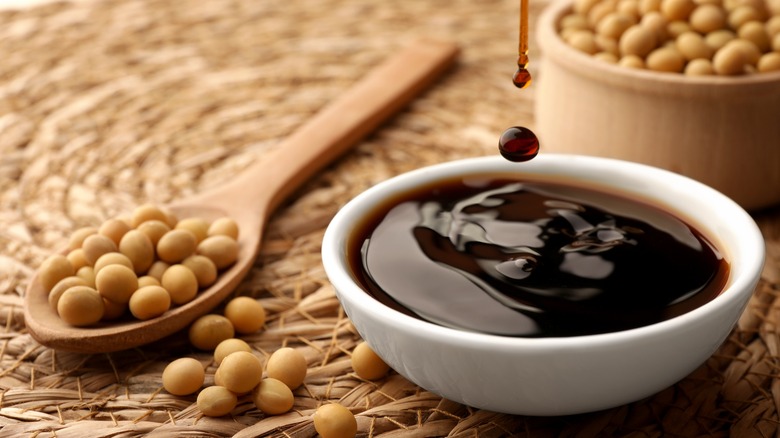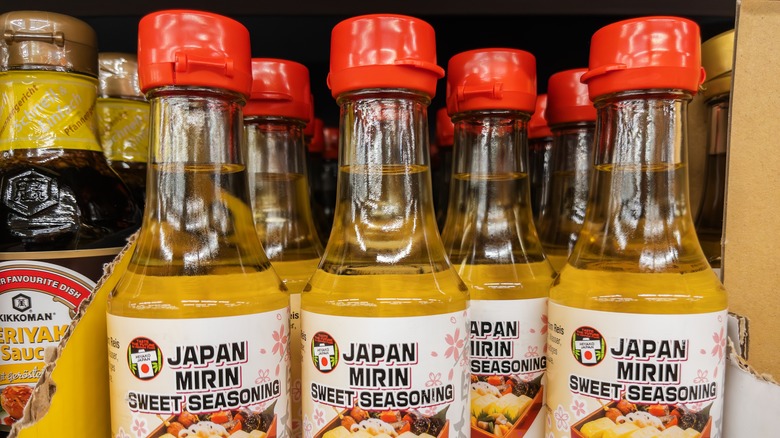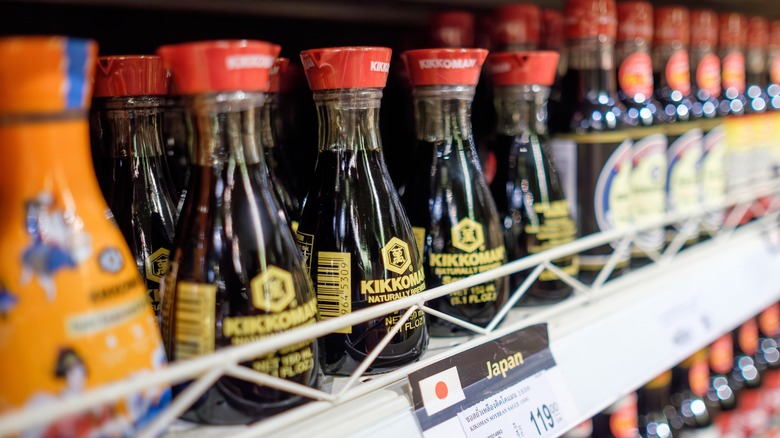What Separates Mirin From Soy Sauce?
If you're trying to build the ultimate umami pantry, then there are a myriad of condiments that can help add flavor to your dishes. But, especially if you like cooking Asian food, you're going to need to keep both mirin and soy sauce on hand, at the bare minimum. Soy sauce, East Asia's iconic seasoning, is a salty, versatile condiment that plays well in a variety of dishes, from savory to sweet. Mirin, on the other hand, has a distinctive flavor that gives iconic Japanese dishes their signature taste.
While often used together, these two condiments couldn't be more different. Mirin, a type of Japanese rice wine, is sweet, almost syrupy, with a tang reminiscent of sake. Soy sauce, originally invented in China, is a liquid condiment made from soybeans, wheat, and salt, which have been fermented and aged with the aid of a bacterial culture. Both products are made using traditional fermentation practices, but they use different ingredients and produce different textures and flavors.
What is mirin?
Mirin, more traditionally called hon-mirin, is made with koji, a type of rice that has been treated with Aspergillus oryzae mold. The resulting koji mold is a popular fermentation tool in Japanese cuisine, and is also used to make miso, sake, and soy sauce. Rice inoculated with koji is added to non-cultured rice and a distilled rice spirit, then allowed to ferment for months or years to make mirin. This is very close to how sake is made, but the mochi rice used for mirin produces a sweeter end product with a lower alcohol content (around 14%, while sake can reach up to 17%).
Mirin is often used to flavor Japanese dishes like niku udon, ramen, and Okinawan soba, as well as sauces like teriyaki. While there aren't any true flavor substitutes for mirin, sake with honey or another sweetener can be used in a pinch. So can dry vermouth or sherry. There are also common imitation mirin products available in grocery stores, called aji-mirin or mirin-fu, which contain almost no alcohol. This makes them a good alternative for those who prefer not to cook with booze, but it is not quite as flavorful as hon-mirin.
What is soy sauce?
Like mirin, soy sauce is made using koji as a fermentation agent. It has been around since 17th-century China, and is still often brewed using a traditional process called honjozo. Soybeans are soaked and then steamed, and wheat is roasted and then crushed before the two are combined with koji to ferment, and later a salt brine, which helps preserve and flavor the soy sauce. Japanese soy sauce is referred to as shoyu, and though it was invented in China, most mainstream soy sauce sold globally today comes from Japan.
There are dozens of different types of soy sauce, which taste differently depending on where they are made, how they are fermented, and how they are seasoned. Koikuchi shoyu, or dark soy sauce, is the most popular variety of soy sauce. Light soy sauce, or usukuchi shoyu, is paler in color than koikuchi shoyu, but often more flavorful, and sometimes even contains mirin. Tamari, another popular variety, is made with only soybeans, as a byproduct of miso, and packs more of a punch than classic soy sauce, since it doesn't contain wheat to add sweetness. All of these can be used to build flavorful sauces and broths, or provide an ideal dipping sauce for sushi or gyoza. In fact, where mirin goes, soy sauce often follows, since both provide such a rich depth of flavor to cuisines in China, Japan, and around the world.



